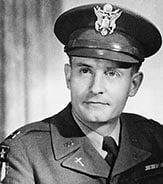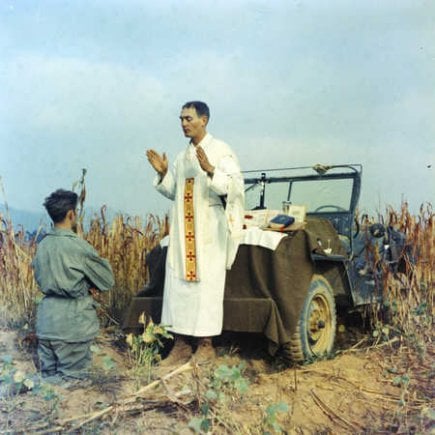
Congressional Medal of Honor Society
Blog Posts
Emil Kapaun: “A Shepherd in Combat Boots”

“Father Kapaun has been called a shepherd in combat boots. His fellow soldiers who felt his grace and his mercy called him a saint, a blessing from God.” President Barack Obama, presenting the Medal of Honor to Father Emil J. Kapaun, April 11, 2013
By Laura Jowdy, Archivist & Historical Collections Manager, CMOHS
On March 5, 2021, the U.S. Defense POW/MIA Accounting Agency announced that Army Chaplain (Capt.) Emil J. Kapaun, a Medal of Honor Recipient, had been accounted for. He had been buried as an Unknown for nearly 70 years in the National Cemetery of the Pacific in Hawaii.
Emil J. Kapaun was born and raised in the small farming community of Pilsen, Kansas. He attended Conception Seminary College in Conception, Missouri, and Kendrick Theological Seminary in St. Louis, Missouri. Four years after his ordination in 1940, he joined the Army’s Chaplain Corps.
During WWII, he served at Fort Wheeler, Georgia, and the Burma-India Theatre. Already, his devotion to his duty was evident. As part of Kapaun’s 1945 recommendation to the rank of captain, Major Bonnie Pearson wrote:
“The untiring, diligent work of Chaplain Kapaun is indeed commendable. …Without regard to his personal comfort he has worked day and night to serve troops from Ledo to Myitkyina.”
He left the service in 1946 and earned a masters from the Catholic University of American in early 1948. By the end of the year, he had rejoined the Chaplain Corps. He was stationed in Texas and Japan as part of the Occupation.
In 1950, he was among the first U.S. troops to land on the Korean peninsula as part of the Korean War, where he became known for running towards the firefights. During quiet times, he was known to use the hood of his Jeep for Mass. He felt his place was where he was needed most: providing solace to those fighting and giving aid and comfort to the wounded or dying.

Kapaun and his courage was most certainly needed during the Battle of Unsan in November 1950. The American force, numbering a few thousand, faced an onslaught of tens of thousands Chinese and Korean troops:
“In the chaos, dodging bullets and explosions, Father Kapaun raced between foxholes, out past the front lines and into no-man’s land – dragging the wounded to safety. When his commanders ordered an evacuation, he chose to stay – gathering the injured and treating their wounds. When the enemy broke through and the combat was hand-to-hand, he carried on – comforting the injured and the dying, offering some measure of peace as they left this earth.” President Barack Obama, Presenting the Medal of Honor to Father Emil J. Kapaun, April 11, 2013
As the final line of the enemy came down, Kapaun worked with an injured Chinese officer to negotiate the safe surrender of the Americans forced to remain behind due to wounds or circumstance.
As the survivors were marched 87 miles north to a Korean prisoner of war camp, Kapaun moved among them, inspiring them to continue through injuries, limited rations, and 30 degrees below zero weather in summer uniforms. He helped carry the wounded and inspired others to do so as well.
In camp, he often defied his captors by holding prayer meetings at night and stealing food. He sacrificed his own self-comfort by volunteering for lowered rations and offering his own clothes to those who had little. Kapaun was praised by his fellow POWs for his efforts to raise morale and gave many a will to live. In short, he continued the same “untiring, diligent work” he was noted for in 1945.
Captain Kapaun died in May 1951 at Pyoktong Prison Camp 5 in Korea and was buried in a mass grave near the camp. Later that year, the Army awarded him the Distinguished Service Cross for his actions. That very same DSC would be upgraded to the Medal of Honor in 2013. His Medal was presented to his nephew, Ray Kapaun, in a White House ceremony. In addition, the Catholic Church named Kapaun a “Servant of God” in 1993, the first step on the way to being declared a saint.
Throughout it all, unknown to everyone, Kapaun’s remains had been returned to America in 1954 during the Korean War Armistice Agreements. Like so many unidentified warriors, he was laid to rest at the National Cemetery of the Pacific in Hawaii. He will soon rest in peace under his proper name.
